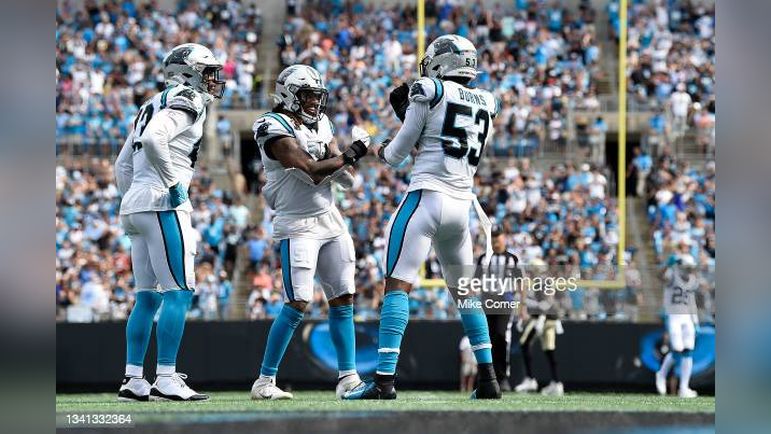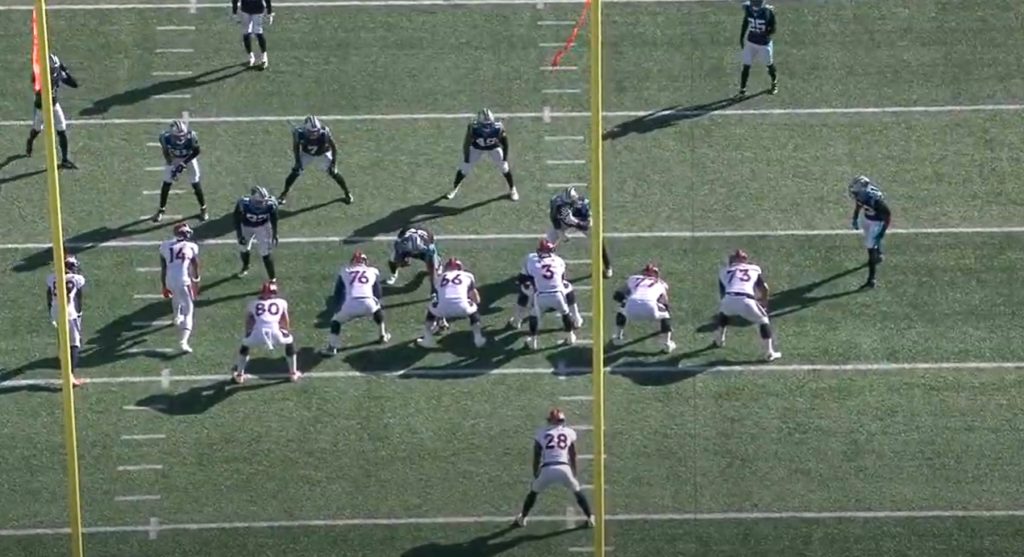As we’ve been doing for several years now, we’ll break down the Pittsburgh Steelers’ opponent each week, telling you what to expect from a scheme and individual standpoint. This year, Jonathan Heitritter and I will cover the opposing team’s defense. I will focus on the scheme, Jonathan on the players.
Continuing things with the Carolina Panthers’ defense.
ALEX’S SCHEME REPORT
PANTHERS RUN DEFENSE
It’s a 4-3 front that’s been a bit below average against the run this year but like most things with this team, they’re trending in the right direction. They’re allowing 4.5 YPC, tied for 20th in the league. However, they’ve allowed 50 runs of 10+ yards, tied for 26th-most in the league. Their leading tackler is LB Shaq Thompson, a good athlete and impressive player while DE Brian Burns is more than a pure pass rusher. He has 55 tackles with a whopping 13 of those for a loss. That’s tied for 8th-most in the league.
On tape in recent weeks, the run defense doesn’t look bad. They are prone to allowing cutbacks on zone schemes but they string perimeter runs out well. Some examples of that below.
They like to stack the box on early downs and play a lot of single high with eight men in the box. Pittsburgh may also want to run weakside against them because there are times when Carolina will very clearly take away your strength. Like here. Definitely can’t run the ball into this.
Some other defensive stats. They have the 22nd-ranked third-down defense (40.6%) and are 17th in the red zone (55.6%) while they’ve forced 14 turnovers this year, tied for 23rd in the league. The Panthers’ defense is allowing 22.3 points per game, 13th overall, but have held their opponent under 16 points in three of their last four games. So again, there’s been progress made here.
PANTHERS PASS DEFENSE
They’re allowing 6.6 YPA, fourth-best in the league, but like most teams with that stat, they’re allowing opposing QBs to complete 65.5% of their passes (21st). They do a decent job keeping a lid on things with just 36 completions of 20+ yards this season, a stat that falls in the top half of the league.
As a defense, they have just 28 sacks this season, 20th in the league. Burns leads the team with 10.5 of them while they get plenty of production from blitzing and rushing their off-ball linebackers like Frankie Luvu (five) and Damien Wilson (two). However, their d-line does a great job of getting their hands up in throwing lanes. Collectively, their line has 13 pass deflections led by DT Derrick Brown’s six. By comparison, the Steelers’ d-line only has seven on the year. So whoever is in at QB, better watch out that their pass isn’t getting tipped and picked.
In the secondary, top-level CB Jaycee Horn leads the team with three INTs, including one in Sunday’s win against the Seattle Seahawks. C.J. Henderson, a former top draft pick, has a pair.
On the year, the Panthers are just 21st in pressure rate at 21.2% despite a top-ten blitz rate, 8th overall at 29.7%. So lots of blitzes and not much pressure. Not a good recipe.
Their defense is relatively bland and basic. A lot of zone, a lot of single-high looks. On early downs, you get more Cover 3. On third down, they will man up as they bring pressure and also play more Cover 2. In the red zone, they are a zone-heavy team and overall, their zone coverage can be flooded. Like here. Watch the Seahawks’ WR get open as Seattle floods the right side.
They blitz on 2nd and most often on third downs, often bringing a nickel corner from the boundary side against 2×2 looks (can’t really blitz the NCB to the boundary in 3×1, he’s almost always to the field). In those situations, #53 Brian Burns will slant down and rush over the guard into the A/B gap so guards will have to handle Burns in addition to the offensive tackles.
Jonathan’s Individual Report
The 5-8 Pittsburgh Steelers travel to Charlotte, North Carolina to face the 5-8 Carolina Panthers Sunday afternoon. The Steelers hit a snag in the road offensively against the Ravens last week, turning the ball over for the first time in a month as QB Mitch Trubisky threw three INTs which essentially sealed Pittsburgh’s fate in a close loss at home. For a team that has shown that they can grind out wins when they run the ball and don’t turn the football over, the offense will have to prepare for a Panthers defense that has several playmakers that are opportunistic on defense in terms of making splash plays.
Defensive Line
The Panthers are led by former first-round pick DL #95 Derrick Brown up front along the defensive line. Brown hasn’t been much of a stat sheet stuffer in terms of sacks and tackles for loss, but he has gradually gotten better with each season, becoming more disruptive as a pass rusher whilst being a quality run stuffer. Standing 6’5″, 320lb, Brown has impressive strength and power at the point of attack, having the ability to manhandle opposing offensive linemen to control gaps and take on blocks. While he doesn’t always get home as a pass rusher, Brown does a great job collapsing the pocket and forcing the QB to scramble outside into the rush off the edge.
Alongside Brown on the DL is #99 Matt Ioannidis. The former Temple Owl and Washington Commander has carved out quite the career for himself after being a fifth-round pick in the 2016 NFL Draft, being a stout run defender with good size (6’3″, 305lb) to take on blocks and fill gaps in run defense. Ioannidis plays with great effort in pursuit as well, making him a viable interior pass rusher. He hasn’t had impressive sack numbers in recent seasons but isn’t too far removed from an 8.5 sack campaign in 2019.
Behind Brown and Ioannidis are DL #83 Bravvion Roy and #78 Marquan McCall who rotate in to give the starters a breather with McCall and Roy being bigger bodies that play their best in run defense.
EDGE
When it comes to edge rushers, the Panthers have one of the best in the league in #53 Brian Burns. Burns is a long, lengthy pass rusher (6’5″, 250lb) that resembles Gumby thanks to his long arms and legs. He came into the league extremely thin but has since packed on muscle and strength and his game has skyrocketed because of it. Burns has great speed and explosiveness off the edge, being able to bend around the corner into the pocket as a pass rusher. He also can blitz from various places on the defensive front, being a chess piece Carolina moves to get an advantageous matchup that he can exploit to get pressure on the QB.
Opposite of Burns is third-year DE #97 Yetur Gross-Matos. Gross-Matos is another long, lean edge rusher (6’5″, 265lb) that tends to struggle with power at times at the point of attack as well as in run defense but does well in terms of using his explosiveness off the LOS to get into OTs to rush the passer. He’s playing roughly 71% of the snaps for Carolina, posting modest sack production as their base DE.
One player that does excel as a speed rusher for the Panthers is #98 Marquis Haynes Sr. Haynes came out of Ole Miss as a slender DE and remains on the lighter side (6’2″, 235lb), but makes up for it with impressive speed and burst off the edge. He has become a good rotational pass rusher for the Panthers, being able to dip and rip around the corner and flatten to the QB for the sack. The Panthers also have #94 Henry Anderson and rookie #90 Amari Barno providing depth with Anderson being a bigger run stuffer and Barno being more like Haynes as a speed pass rusher.
Linebackers
The linebacker core for the Panthers is led by #7 Shaq Thompson who has taken the torch from Luke Kuechly and Thomas Davis as the new leader in the box for Carolina. Thompson is a good athlete, having the speed to run sideline-to-sideline as well as come downhill and shoot gaps as a run defender and blitzer. He represents himself well in zone coverage, having the instincts to break on the football in the air. Thompson is a lighter ILB (6’0″, 230lb) making him susceptible to getting covered up on blocks if OL get their hands on him.
One player that has climbed the depth chart and has made himself quite the player for the Panthers is LB #49 Frankie Luvu. Luvu came out of Washington State in 2018 and started out as a backup/special teamer, seeing seven starts in the last two seasons before becoming a full-time starter this season. He has thrived in that expanded role, posting 78 total tackles, 12 TFLs, five sacks, three PBUs, a forced fumble, and an INT returned for a TD. Luvu plays with great pursuit of the football and is an instinctual player, having a knack for shooting gaps and breaking on the ball in coverage.
#57 Damien Wilson also sees a fair amount of play time for the Panthers at off-ball LB but has seen his snaps drop as Luvu has taken more work and Wilson being more of an early-down run defender. #55 Cory Littleton also mixes in at LB for Carolina as an experienced veteran along with #50 Chandler Wooten, #52 Joel Iyiegbuniwe, and #40 Brandon Smith who mainly play special teams and are depth players on defense.
Cornerbacks
The Panthers invested a top-10 pick in the 2021 NFL Draft in CB #8 Jaycee Horn and Horn’s play this season is making that selection look like a wise investment. After only playing in three games last season due to injury, Horn has become a full-time starter in the secondary and a quality pass coverage defender for Carolina, posting 44 total stops, seven PBUs, and three INTs so far in 2022. Horn is extremely physical at the LOS in press-man coverage but also has good instincts to break off his assignment in zone and make a play on the football. He is also a strong tackler, making the 6’1″, 200lb CB the full package.
Opposite Horn in the secondary for the Panthers is a player I got to know well during my time at the University of Florida, CB #24 C.J. Henderson. Henderson was drafted by the Jaguars in the top-10 of the 2020 NFL Draft but got shipped off the Carolina the next season. A great athlete, Henderson has the size and speed (6’1″, 204lb) to run with most receivers in coverage. His tackling is a little shaky and his quickness in short areas is suspect, but he is finding his footing this season as a full-time starter, breaking up five passes while picking off two others.
Also in the secondary for Carolina is #27 T.J. Carrie who is a well-traveled veteran who brings good size to the table (6’0″, 205lb), but lacks great instincts when the ball is in the air along with foot quickness. Joining Carrie is #28 Keith Taylor who is another long, lanky corner (6’3″, 195lb) that plays his best ball with the receiver in front of him and when allowed to get hands on but can struggle if having to keep up with speed and quickness down the field or at the breaking point at the top of the route.
Safeties
The do-it-all player in the secondary for the Panthers is S #21 Jeremy Chinn. Chinn moves all over the defense for Carolina, having the size and athleticism (6’3″, 220lb) to roll up into the box as a sub-package linebacker, play split zone or single high safety, or roll down and play in the slot as the nickel/dime defender. He had a standout performance as a rookie in 2020 and while he has missed some time in 2022 due to injury, his presence as that moveable chess piece has proven invaluable to the Panthers as that defender who can run, blitz, and cover.
Next to Chinn at safety is #25 Xavier Woods, who is currently questionable with a back injury and missed last week’s game against the Seahawks. The long-time Cowboy and Viking found his way to Carolina this offseason and has been a solid, albeit unspectacular play from a safety that is willing and able in run support but occasionally gets lost in coverage. DB #38 Myles Hartsfield has seen plenty of run this season for the Panthers, logging eight starts and has 48 combined tackles, two TFLs, a forced fumble and two PBUs. #31 Justin Burris also gets some run as a rotational piece/special teamer, logging 20 total stops on the year. #34 Sean Chandler and #42 Sam Franklin Jr. round out the DB room for Carolina.









